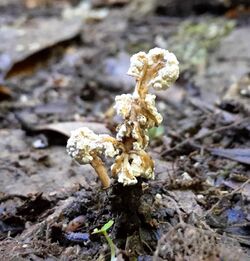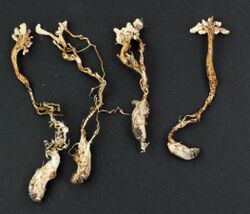Biology:Isaria sinclairii
| Isaria sinclairii | |
|---|---|

| |
| Scientific classification | |
| Domain: | Eukaryota |
| Kingdom: | Fungi |
| Division: | Ascomycota |
| Class: | Sordariomycetes |
| Order: | Hypocreales |
| Family: | Cordycipitaceae |
| Genus: | Isaria |
| Species: | I. sinclairii
|
| Binomial name | |
| Isaria sinclairii (Berk.) Lloyd
| |
| Synonyms [1] | |
| |
Isaria sinclairii is a species of entomopathogenic fungus mostly infecting the underground nymphs of cicadas. It produces myriocin, from which the synthetic drug fingolimod, a treatment for multiple sclerosis, was developed.
Taxonomy
Isaria sinclairii is the name of the anamorph; the teleomorph is Cordyceps sinclairii, Cordycipitaceae.[1] The species was first described in 1855 by Miles Joseph Berkeley from specimens collected in the garden of Archdeacon William Williams at Tūranga, Poverty Bay.[2] It was moved to the genus Isaria in 1923 by Curtis Gates Lloyd.[3]
Ecology
Isaria sinclairii is a fungus which attacks insects, including cicada larvae. The larvae typically die just beneath the soil surface, and the fungus produces white tufts which grow up from the soil and release powdery white spores.[4] I. sinclairii is found from Asia (particularly China, Japan, and Korea) through to New Zealand. In New Zealand it attacks cicadas of the genera Amphipsalta and Melampsalta.[5][6] In the lab it can be cultured on the bodies of silkworms.
Uses
Isaria sinclairii and similar vegetable caterpillar species such as Ophiocordyceps sinensis have been used in traditional Tibetan medicine and in traditional Chinese medicine as tonics believed to impart eternal youth.[7][8] A sphingolipid derivative produced by I. sinclairii, myriocin, was discovered to have powerful immunosuppressive properties, a function of the way the fungus attacks living insects.[9][7] Because myriocin is too toxic to use in humans, a synthetic derivative was developed in 1992, named FTY720 or fingolimod.[10][8] Under its trade name Gilenya, fingolimod was approved by the FDA in 2010 as the first oral drug for treating the autoimmune disease multiple sclerosis.[9] Fingolimod shows promise as a cancer medication,[11] and has been tested as a possible treatment for obesity.[12]
References
- ↑ 1.0 1.1 "Species: Isaria sinclairii (Berk.) Lloyd [stat. anam.], Mycological Writings 7: 1179 (1923)". New Zealand Fungi. Landcare Research. https://biotanz.landcareresearch.co.nz/scientific-names/1cb18307-36b9-11d5-9548-00d0592d548c.
- ↑ Hooker, Joseph Dalton (1855). The botany of the Antarctic voyage of H.M. discovery ships Erebus and Terror in the Years 1839–1843. 2. London: Reeve Brothers. pp. 348. https://www.biodiversitylibrary.org/item/54142#page/348/mode/1up.
- ↑ Lloyd, C. G. (1923). "Mycological Notes 68". Mycological Writings 7 (68): 1169–1184.
- ↑ "Isaria". Fungal Guide. Landcare Research. http://fungalguide.landcareresearch.co.nz/WebForms/FG_Genus.aspx?Group=Isaria&pk=5008.
- ↑ Glare, Travis; O'Callaghan, Maureen; Wigley, Peter J. (1993). "Checklist of naturally occurring entomopathogenic microbes and nematodes in New Zealand". New Zealand Journal of Zoology 20 (2): 95–120. doi:10.1080/03014223.1993.10422867.
- ↑ Cunningham, G.H. (1921). "The genus Cordyceps in New Zealand". Transactions of the Royal Society of New Zealand 53: 372–382. http://rsnz.natlib.govt.nz/image/rsnz_53/rsnz_53_00_0487_0372_ac_01.html.
- ↑ 7.0 7.1 Tetsuro Fujita; Kenichiro Inoue; Satoshi Yamamoto; Takeshi Ikumoto; Shigeo Sasaki; Ryousuke Toyama; Kenji Chiba; Yukio Hoshino et al. (1994). "Fungal metabolites. Part 11. A potent immunosuppressive activity found in Isaria sinclairii metabolite". The Journal of Antibiotics 47 (2): 208–215. doi:10.7164/antibiotics.47.208. PMID 8150717.
- ↑ 8.0 8.1 Strader, C.R.; Pearce, C.J.; Oberlies, N.H. (2011). "Fingolimod (FTY720): a recently approved multiple sclerosis drug based on a fungal secondary metabolite". Journal of Natural Products 74 (4): 900–907. doi:10.1021/np2000528. PMID 21456524.
- ↑ 9.0 9.1 Burridge, Samia (October 27, 2010). "Myriocin". Lipid Maps. doi:10.1038/lipidmaps.2010.34. http://www.lipidmaps.org/update/2010/101101/full/lipidmaps.2010.34.html. Retrieved March 26, 2011.
- ↑ Tetsuro Fujita; Kenichiro Inoue; Satoshi Yamamoto; Takeshi Ikumoto; Shigeo Sasaki; Ryousuke Toyama; Kenji Chiba; Yukio Hoshino et al. (1994). "Fungal metabolites. Part 12. Potent immunosuppressant, 14-deoxomyriocin, (2S,3R,4R)-(E)-2-amino-3,4-dihydroxy-2-hydroxymethyleicos-6-enoic acid and structure-activity relationships of myriocin derivatives". The Journal of Antibiotics 47 (2): 216–224. doi:10.7164/antibiotics.47.216. PMID 8150718.
- ↑ White, C.; Alshaker, H.; Cooper, C.; Winkler, M.; Pchejetski, D (2016). "The emerging role of FTY720 (Fingolimod) in cancer treatment". Oncotarget 7 (17): 23106–23127. doi:10.18632/oncotarget.7145. PMID 27036015.
- ↑ Ahn, M.Y.; Jee, S.D.; Lee, B.M. (2007). "Antiobesity effects of Isaria sinclairii by repeated oral treatment in obese Zucker rats over a 4-month period". Journal of Toxicology and Environmental Health, Part A 70 (15–16): 1395–1401. doi:10.1080/15287390701428556. PMID 17654260.
External links
- ARS Collection of Entomopathogenic Fungal Cultures[yes|permanent dead link|dead link}}]
- Isaria sinclairii discussed on RNZ Critter of the Week, 25 January 2019
Wikidata ☰ Q6078965 entry
 |



